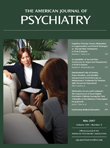Assessment of Self-Injurious Thoughts Using a Behavioral Test
Abstract
Objective: The assessment of self-injurious thoughts has been limited by a reliance on what individuals are willing or able to report explicitly. The authors examined a new method that measures self-injurious thoughts by using individuals’ reaction times to self-injury-related stimuli on a computerized test. Method: Eighty-nine adolescents who were not self-injurious (N=36) or had recently engaged in nonsuicidal self-injury (N=53) completed two versions of the Self-Injury Implicit Association Test, which measure the automatic association of self-injury with oneself and with favorableness. Results The tests revealed significant behavioral differences between the self-injurers and noninjurers. Moreover, test scores significantly improved the statistical prediction of nonsuicidal self-injury beyond that achieved with demographic and psychiatric factors. Conclusions: These initial results support the validity of the Self-Injury Implicit Association Test as a performance-based measure of self-injurious thoughts. Future research should further examine the usefulness of incorporating implicit measures in risk assessment and decision-making procedures for self-injury and other sensitive clinical behaviors.



